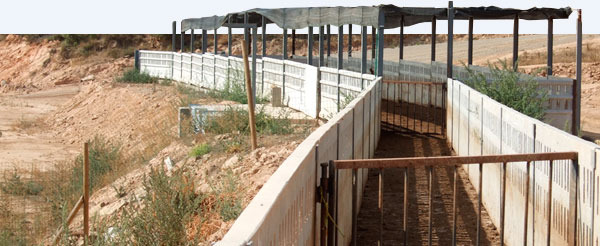Article
An experimental model to evaluate the role of transport vehicles as a source of transmission of porcine reproductive and respiratory syndrome virus to susceptible pigs. Scott A. Dee, John Deen, Satoshi Otake, and Carlos Pijoan. Can J Vet Res. Apr 2004; 68(2): 128–133

Article brief
What are they studying?
Since a contaminated transport vehicle constitutes a potential route of PRRSV transmission, a study was carried out to evaluate the role of vehicles in the transmission of PRRSV. The aims of the study were:
- Defining the concentration of PRRSV in the vehicle needed to infect pigs,
- Verifying that contaminated model trailers can transmit PRRSV to pigs,
- Assessing transport-vehicle sanitation protocol to avoid transmission of PRRSV
How is it done?
They used 16-to-18-day-old PRRSV-naïve pigs, and the unit was a weaned-pig trailer. The model replicates a full-size weaned-pig trailer and was built to a 1:150 scale.
Arm 1: Dilutions of PRRSV (101, 102, 103, and 104 TCID50/mL) were prepared in 5-mL aliquots and were sprayed over the interior of the trailer, and then PRRSV-naïve sentinel pigs were placed there for 2 h.
Arm 2: 4 PRRSV-naïve pigs were infected with 2 mL of PRRSV and then placed in the model trailer for 2 h. After this contamination period, the “seeder pigs” were removed and 2 PRRSV-naïve sentinel pigs were placed in each trailer for 2 h.
Arm 3: 4 different sanitation procedures were studied, after a 2-h contamination period, the trailers were assigned 1 of 4 treatments. 10 replicates were conducted.
Treatment 1-Scraping only: The trailer interior was manually scraped, with a hand-held plastic scraper, to remove soiled wood-chip bedding before placement of 2 sentinel pigs.
Treatment 2-Wash and disinfect: The bedding was removed and the trailer washed and disinfected before placement of 2 sentinel pigs.
Treatment 3-Wash, disinfect, freeze, and thaw: The bedding was removed and the trailers were washed and disinfected as described for treatment 2. In addition, the trailers were placed in a chest freezer overnight at −20°C and allowed to thaw before placement of 2 sentinel pigs.
Treatment 4-Wash, disinfect, and dry: The bedding was removed and the trailers were washed and disinfected as described for treatments 2 and 3. Then the trailers were allowed to dry for 12 h at room temperature (20°C) before placement of the 2 sentinel pigs.
After all treatments, 2 PRRSV-naive sentinel pigs were housed in the trailers for 2 h, removed, and kept in a separate pen for 7 d. During the incubation period, all sentinel pigs were blood-tested on days 3 and 7 after exposure.
What are the results?
Pigs exposed to trailers contaminated with 103 TCID50/mL or 104 TCID50/mL were serum PCR-positive on days 3 and 7 after exposure.
Also, at least 1 sentinel pig was infected in trailers after the contamination by other piglets took place.
Only the wash/disinfect/dry treatment reduced the number of PCR-positive swabs from trailer interiors, and prevented the infection of sentinel pigs.
What implications does this paper have?
It confirms that “all trucks, trailers, and other vehicles used for transporting animals, animal products, products, feed, offal, and contaminated equipment are a potential risk in the spread of disease”. Unless the interior of the transport vehicle is completely dry after washing and disinfection, contamination is possible.
|
Unfortunately, it is common for those farms in areas of high pig density to blame their low health status on their geographical location, and for those in areas of lower density to blame it on the origin of their animals, the feed lorries, carcase collection, the wind, winter or just bad luck. We rarely consider the animals transport vehicles as a possible route of disease transmission, and when we do, we think the danger lies on the outside of the vehicle. That's why disinfectant wheel dips and drive-through vehicle disinfecting systems are set up. Once the lorry is disinfected (on the outside) it seems the danger is over. However, there's always an excuse to exonerate the inside of the trailer when talking about the possibility of it being contaminated: my workers have no contact with it, pigs do not step back into the farm, my transport vehicle is always clean when it comes in, or we have loading bays. But are lorries always clean on arrival? Is the driver ever contacted? Don't pigs ever step on the elevator and go back into the farm? The article shows how easy it is to infect pigs with PRRS virus when they come in contact with a contaminated transport vehicle (where viraemic pigs have been transported), even when it is washed (even with water at 80 °C, as in the case of the article) and disinfected. True, it is still an experimental design, but the scenarios described are norm under field conditions: Lorry trailer designs are not ideal for washing and disinfection purposes: the box is full of angles, hinges, locks, making it specially difficult; but also, in practice, the driver himself is responsible for cleaning the lorry, the cleaning bay has no hot water, there is a single entry and exit point, and there is no definition of clean and dirty areas; when the weather is cold, it is common for lorries to be still wet at the time of loading a new batch of animals; or the driver never washes his gloves or the tools used during loading, let alone his boots. Taking all this into account, how can we tell whether a transport vehicle is clean by just taking a glimpse? A farm cannot exist without a transport means that allows it to send pigs to slaughter, take them to the finishing unit or introduce replacements. But how can we minimize the risks it may pose? There are some steps you can take: 1. Try to reduce loads to a minimum. Taking weekly loads to slaughter in order to reduce the non-productive days per sow commonly takes priority over reducing their frequency, even if costs are higher. 2. Where possible, ensure lorries are thoroughly dried. Downtime periods before visiting genetic centres or between transport of pigs for slaughter and transport of pigs to other farms are crucial to reduce risks. Again, they increase costs but improve biosecurity. 3. Even if all of the above are applied, it is always safest to assume the lorry is dirty. If we do so, we will take every precaution to prevent direct contact between the farm and the lorry. Contact should always happen in a loading bay with perfectly defined clean and dirty —where the driver should remain— areas, where liquids and animals are prevented from re-entering the farm; this loading bay must be washed and disinfected immediately after each use, always from the clean to the dirty area. Ideally, the loading bay is away from the barns and it has waiting pens available.
4. Do not allow the driver to use his own tools. Provide footwear, gloves etc. from outside the farm. No matter how good our PRRS control on farm is, if we don't control new virus introductions, the disease will affect the herd frequently, with a frequency inversely proportional to the level of biosecurity on animal transport. |











